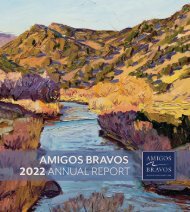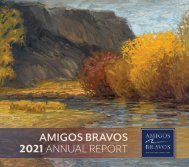Create successful ePaper yourself
Turn your PDF publications into a flip-book with our unique Google optimized e-Paper software.
Holding Polluters Accountable<br />
3. AMIGOS BRAVOS HAS BEEN<br />
A PROPONENT OF LEGISLATION<br />
DESIGNED TO REGULATE SPILLS<br />
OF TOXIC WASTEWATER FROM THE<br />
OIL AND GAS INDUSTRY AND WILL<br />
CONTINUE THE FIGHT.<br />
“Produced water” is a benign-sounding term<br />
for what should more accurately be called<br />
“wastewater from oil and gas operations.”<br />
In the process of extracting oil and gas from<br />
subsurface formations, a lot of produced<br />
water is also generated as a byproduct.<br />
Some estimates say that for every barrel of oil<br />
produced, an average of about 10 barrels of this<br />
water (although it varies widely depending on<br />
location) is also produced.<br />
In the arid west, it is tempting to look at this as<br />
a potential source of “new” water. In addition,<br />
this wastewater is a headache for the oil and<br />
gas industry because it is expensive for them to<br />
dispose of it. Consequently, there is a movement<br />
across the country to figure out ways to<br />
“safely” reuse this wastewater. The New Mexico<br />
legislature added its own impetus in the 2019<br />
legislative session, by passing HB546 (which<br />
includes “The Produced Water Act”) and charges<br />
New Mexico regulatory agencies with studying<br />
the issue of the use, disposal, and potential<br />
reuse applications of produced water, and to<br />
commence rule-making based on their findings.<br />
It has long been legal in New Mexico for the<br />
oil and gas industry to reuse produced water<br />
within the industry, for example as a source of<br />
water for fracking operations, etc. This type of<br />
reuse at least has the benefit of lessening the<br />
use of freshwater resources for such purposes.<br />
Produced water that is not reused in this way is<br />
typically put in evaporation pits or re-injected in<br />
deep disposal wells. However, cheerleaders for<br />
additional applications of produced water have<br />
been advocating for using it in roadbuilding and<br />
construction, discharge to surface water bodies,<br />
and even for crop irrigation.<br />
The problem with using produced water outside<br />
the industry is that it contains many unknown<br />
pollutants. First and foremost, it is almost always<br />
highly saline (“saltwater”) and not usable for<br />
humans, animals, or crops without treatment.<br />
In addition to salt, produced water often<br />
contains constituents found in oil production,<br />
including carcinogens such as benzene, toluene,<br />
ethylbenzene, and xylene. New Mexico’s unique<br />
geology often introduces other dangerous<br />
constituents, such as arsenic and radionuclides<br />
such as radium. Beyond these predictable<br />
16 |







